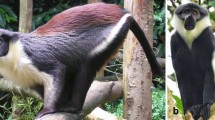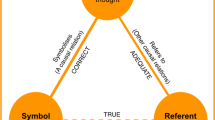Abstract
In a recent exchange, Pareja et al. (Primates 61: 159–168, 2020a; Primates 61: 767–774, 2020b) and Urbani and Youlatos (Primates, https://doi.org/10.1007/s10329-020-00825-2, 2020a) dispute the re-interpretation of the primate species depicted in a Bronze Age fresco from Room 6 of Building Complex Beta at Akrotiri, Thera. They review the history of interpretations of this artwork and combine the expertise of scholars that traditionally focus on such research with the scientific expertise of primatologists to reexamine the artwork. Additionally, they emphasize the morphological traits exhibited by these painted primates. We review and expand their list of candidate primates here in a decision table to demonstrate that the African link is better supported by the morphological traits than the Asian one proposed by Pareja et al. (2020a, b). Using such evidence, we show that other guenons of the tribe Cercopithecini, such as L’Hoest’s monkey (Allochrocebus lhoesti) and the Diana monkey (Cercopithecus diana), provide equal support for the African link as the vervet monkey proposed by Urbani and Youlatos (2020a). However, the historical context supports the traditional interpretation that the Akrotiri fresco depicts vervet monkeys from this region. This discourse provides an open forum for scholars in various fields to contribute to an important problem that crosses disciplinary boundaries.





Similar content being viewed by others
References
Dominy NJ, Ikram S, Moritz GL, Wheatley PV, Christensen JN, Chipman JW, Koch PL (2020) Mummified baboons reveal the far reach of early Egyptian mariners. eLife. https://doi.org/10.7554/eLife.60860
Greenlaw C (2011) The representation of monkeys in the art and thought of Mediterranean cultures. BAR Int Ser 2192:89
Pareja MN, McKinney T, Mayhew JA, Setchell JM, Nash SD, Heaton R (2020a) A new identification of the monkeys depicted in a Bronze Age wall painting from Akrotiri, Thera. Primates 61:159–168
Pareja MN, McKinney T, Setchell JM (2020b) Aegean monkeys and the importance of cross-disciplinary collaboration in archaeoprimatology: a reply to Urbani and Youlatos. Primates 61:767–774
Urbani B, Youlatos Y (2020a) Occam’s razor, archaeoprimatology, and the “blue” monkeys from Thera: a reply to Pareja et al. (2020). Primates. https://doi.org/10.1007/s10329-020-00825-2
Urbani B, Youlatos Y (2020b) A new look at the Minoan ‘blue’ monkeys. Antiquity 94(e9):1–5
Acknowledgements
Special thanks go to Kathy Connor for bringing the original article to the attention of the first author. We would also like to thank the authors of the articles cited here for providing an interesting opportunity for primatologists to contribute to an important anthropological issue. The input of two anonymous reviewers greatly enhanced this manuscript.
Author information
Authors and Affiliations
Corresponding author
Ethics declarations
Conflict of interest
The authors declare that no conflict of interest exists.
Ethical approval
No studies with nonhuman primates or human participants were undertaken in connection with this article.
Additional information
Publisher's Note
Springer Nature remains neutral with regard to jurisdictional claims in published maps and institutional affiliations.
About this article
Cite this article
Pruetz, J.D., Greenlaw, C. Occam’s razor revisited: guenon species morphology supports evidence for an African influence in Bronze Age Aegean fresco primate iconography from Akrotiri, Thera. Primates 62, 703–707 (2021). https://doi.org/10.1007/s10329-021-00930-w
Received:
Accepted:
Published:
Issue Date:
DOI: https://doi.org/10.1007/s10329-021-00930-w




